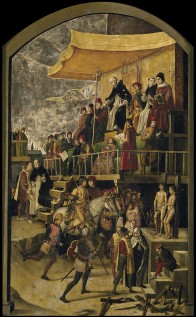
The phrase ‘The Spanish Inquisition’ which is so often used as an everyday colloquialism actually finds its roots in the twelfth century surprisingly in France rather than Spain. For many parts of Europe the Inquisition ran into the nineteenth century. The Inquisition began as a sect of the Church which sought to seek out heretics and in particular the Cathar and Waldensian groups within the Kingdom of France. In the subsequent centuries however, the inquisition expanded across the continent and was an institution which enforced orthodox conversions from Judaism and Islam into Christianity, this occurred predominantly in Spain, thus the coining of the term.
The Spanish inquisition which was established in 1478 saw a movement away from the Papal inquisition from the late medieval period with a greater emphasis on the movement and expulsion of religious minorities. Ferdinand II decreed in 1492 that all minorities either convert or leave. The reasoning behind the origins of the Inquisition in Spain can be traced to growing monarchic power and the increased desire to supress conversos: coverts into the faith. The inquisition was called upon to control a number of sacrilegious acts, including most famously witchcraft, sodomy and heresy in the broadest sense but also as stated, with a primary focus on the expulsion of Jews.
The latter is an aspect which truly reached its peak in the early sixteenth century, when the greatest levels of migration occurred and has been focussed on most heavily in popular culture as evidenced by Phillipa Gregory’s The Queen’s Fool. During this time, it is estimated half of the minority groups chose migration and to other Christian nations, rather than Muslim lands as would be assumed, again highlighted in The Queen’s Fool. As for witchcraft, in Spain, unlike the rest of Europe there was a greater degree of scepticism behind the orthodoxy of true witchcraft and was predominantly labelled superstition. One case however which merits consideration is that of Logrono, where 11 people, notably all women were burned.
A more pressing concern for the crown was sodomy however which really did bear the brunt for some of the harsher and crueller forms of torture and punishment. Starvation and water torture were not uncommon methods used to get confessions, but once convicted castration, public burnings and executions were the most common forms of punishment, where the accused could not seek penance.
Going back to popular culture, it is important however to dispel certain myths regarding the popularity and dependency on the use of some forms of torture, namely the open coffin pecked at by birds which is cinematised in Monty Python’s Holy Grail. It is also important to note that Spain was in many ways more relaxed and far more cautionary in using torture as a means of gaining information or punishment, despite popular perceptions.
